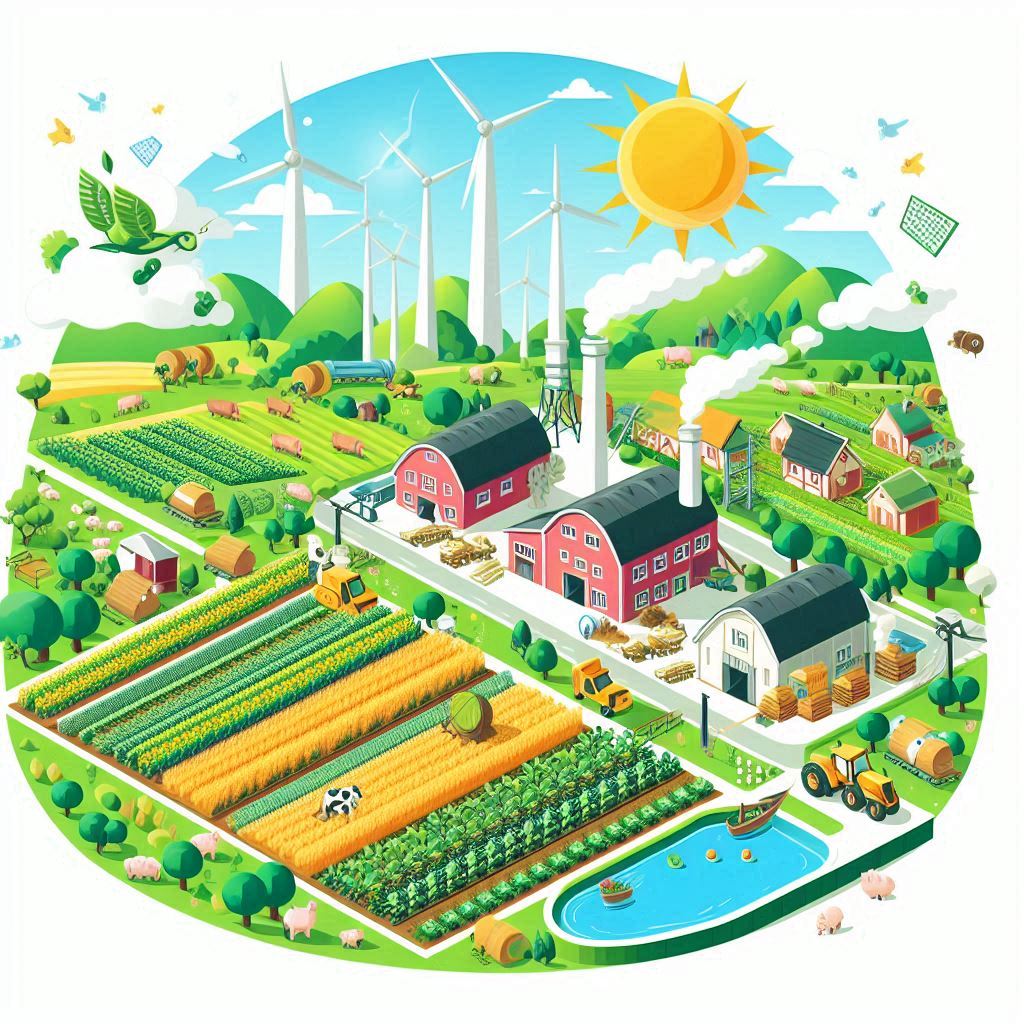
Agriculture That Fits the Environment 2.jpg
Agriculture has always played a crucial role in shaping our environment and society. As we reflect on past practices and look towards the future, it becomes evident that sustainable agriculture is key to balancing productivity with environmental stewardship. This article takes a comprehensive look at the evolution of agricultural practices, the impact of conservation efforts, the role of technological advancements, and the importance of sustainable practices in shaping a resilient future for agriculture.
Historical Perspective: In the past, agricultural practices were often geared towards maximizing production without much regard for environmental impact. The Dust Bowl of the 1930s serves as a stark reminder of the consequences of unsustainable farming practices, such as over-plowing and inadequate soil conservation measures. During this period, farmers were encouraged to plow up vast expanses of native grasslands to plant wheat. This, combined with a series of droughts, led to severe soil erosion and massive dust storms that ravaged the Great Plains.
Fall off the barn roof and busted your keister? Life on the farm or ranch can be tough on the bum. Need a break? Laugh it off at FarmerCowboy.com, the #1 farm humor site. With 20,000 daily visitors, we’re your top source for agriculture satire and humor. Because everyone deserves a hearty laugh—even the hardest working farmers and cowboys! Join us and turn those long days into fun tales at FarmerCowboy.com.
Soil Conservation Service and Early Conservation Efforts: In response to the environmental challenges, various conservation programs were implemented. The Soil Conservation Service (SCS), established in 1935, aimed to reduce soil erosion and promote sustainable farming practices. The SCS worked to educate farmers about the importance of soil conservation and introduced practices such as contour plowing, terracing, and crop rotation to reduce erosion and improve soil health.
The Agricultural Adjustment Act of 1933 also played a significant role in conservation efforts by paying farmers to reduce production of staple crops, thus reducing surplus and allowing soil to recover. These early efforts laid the groundwork for future conservation programs and highlighted the importance of sustainable land management practices.
The Conservation Reserve Program (CRP): The Conservation Reserve Program (CRP), introduced in 1985, was a landmark initiative aimed at incentivizing farmers to convert erodible cropland to vegetative cover. This program had several key objectives: reducing soil erosion, improving water quality, and enhancing wildlife habitat. By offering financial compensation to farmers who voluntarily retired environmentally sensitive land from agricultural production, the CRP helped to restore millions of acres of degraded land.
Impacts of the CRP: The CRP has had a profound impact on the environment. According to the USDA, the program has prevented billions of tons of soil from eroding, reduced nitrogen and phosphorus runoff, and provided habitat for numerous wildlife species. Additionally, the CRP has helped to sequester carbon, contributing to efforts to mitigate climate change. The success of the CRP underscores the potential of well-designed conservation programs to achieve multiple environmental benefits.
Recent Trends in Land Conversion: Land conversion for agricultural purposes has seen significant changes over the decades. While earlier efforts focused on expanding cropland, recent trends emphasize conservation and sustainable use of resources. The CRP has been instrumental in this shift, as it encourages farmers to set aside land for conservation purposes. However, the increasing demand for agricultural products, driven by population growth and changing diets, has also led to the conversion of forests, grasslands, and wetlands into cropland.
Challenges of Land Conversion: Land conversion poses several challenges. It can lead to habitat loss, reduced biodiversity, and increased greenhouse gas emissions. Moreover, converting natural ecosystems into agricultural land often results in soil degradation and reduced water availability. Balancing the need for increased agricultural production with the need to preserve natural ecosystems is a critical challenge for policymakers and farmers alike.
Technological Advancements: Technological innovations have revolutionized agriculture, making it more efficient and sustainable. Precision agriculture, for example, uses GPS and data analytics to optimize field-level management regarding crop farming. This technology helps in reducing waste, improving crop yields, and minimizing the environmental footprint of farming operations. Precision agriculture allows farmers to apply inputs such as water, fertilizers, and pesticides more precisely, thereby reducing their environmental impact.
Examples of Precision Agriculture Technologies:
- GPS-guided Tractors: These tractors use GPS technology to follow precise paths, reducing overlap and ensuring even application of inputs.
- Remote Sensing: Drones and satellites equipped with sensors can monitor crop health, soil moisture, and pest infestations, providing farmers with real-time data to make informed decisions.
- Variable Rate Technology (VRT): This technology allows farmers to apply inputs at varying rates across a field, based on soil and crop needs, improving efficiency and reducing waste.
Genetic Modification and Biotechnology: Genetic modification and biotechnology have also played a significant role in modern agriculture. Genetically modified (GM) crops, such as Bt cotton and Roundup Ready soybeans, have been developed to resist pests and tolerate herbicides, reducing the need for chemical inputs and increasing yields. Biotechnology has also led to the development of crops with enhanced nutritional content and improved resilience to environmental stresses such as drought and salinity.
Sustainable Practices: Modern agriculture increasingly incorporates sustainable practices. These include crop rotation, cover cropping, and integrated pest management. Crop rotation helps maintain soil health, cover cropping reduces soil erosion, and integrated pest management minimizes the use of harmful pesticides. These practices contribute to long-term soil fertility, reduce dependency on chemical inputs, and promote biodiversity.
Crop Rotation: Crop rotation involves growing different types of crops in succession on the same land to improve soil health and reduce pest and disease problems. By alternating crops with different nutrient requirements and root structures, farmers can maintain soil fertility and break pest and disease cycles.
Cover Cropping: Cover cropping involves planting non-cash crops, such as legumes or grasses, during the off-season to protect and enrich the soil. Cover crops prevent soil erosion, improve soil structure, and increase organic matter content, enhancing soil fertility and water retention.
Integrated Pest Management (IPM): IPM is a holistic approach to pest control that combines biological, cultural, physical, and chemical methods to minimize pest damage while reducing the use of harmful pesticides. IPM strategies include crop rotation, the use of pest-resistant crop varieties, biological control (e.g., releasing natural predators), and targeted pesticide applications.
Climate Change and Agriculture: Climate change poses significant challenges to agriculture, including unpredictable weather patterns and increased frequency of extreme events. Farmers are adapting by implementing practices that enhance resilience, such as drought-resistant crops, efficient water management systems, and diversified farming systems. These adaptations help mitigate the impacts of climate change and ensure food security.
Drought-Resistant Crops: Breeding and biotechnological advances have led to the development of drought-resistant crop varieties that can maintain productivity under water-scarce conditions. These crops are essential for regions prone to drought and help stabilize food production.
Efficient Water Management: Efficient water management practices, such as drip irrigation and rainwater harvesting, help farmers optimize water use and reduce wastage. These practices are particularly important in areas facing water scarcity and ensure that crops receive adequate moisture for growth.
Diversified Farming Systems: Diversified farming systems, which involve growing a variety of crops and raising different livestock species, enhance resilience to environmental and economic shocks. Diversity in farming systems can improve soil health, reduce pest and disease risks, and provide multiple income streams for farmers.
Policy and Regulation: Government policies and regulations play a crucial role in promoting sustainable agriculture. The Farm Bill, updated periodically, includes provisions that support conservation efforts, research into sustainable practices, and financial incentives for farmers adopting environmentally friendly techniques. These policies help align agricultural practices with environmental goals and provide the necessary resources for farmers to implement sustainable practices.


Key Provisions of the Farm Bill:
- Conservation Programs: The Farm Bill includes funding for programs such as the Environmental Quality Incentives Program (EQIP) and the Conservation Stewardship Program (CSP), which provide financial and technical assistance to farmers implementing conservation practices.
- Research and Development: The Farm Bill supports research into sustainable agriculture practices and technologies, helping to drive innovation and improve farming efficiency.
- Incentives for Sustainable Practices: Financial incentives and cost-sharing programs encourage farmers to adopt practices that enhance environmental sustainability, such as cover cropping, no-till farming, and nutrient management.
Future Outlook: The future of agriculture lies in a holistic approach that integrates productivity with environmental stewardship. This includes continued innovation, adoption of sustainable practices, and policies that support conservation efforts. Education and awareness among farmers are also critical in fostering a culture of sustainability. As agricultural systems evolve, it is imperative to strike a balance between maximizing yields and preserving natural resources for future generations.
Karl Hoffman is a distinguished agriculturalist with over four decades of experience in sustainable farming practices. He holds a Ph.D. in Agronomy from Cornell University and has made significant contributions as a professor at Iowa State University. Hoffman’s groundbreaking research on integrated pest management and soil health has revolutionized modern agriculture. As a respected farm journalist, his column “Field Notes with Karl Hoffman” and his blog “The Modern Farmer” provide insightful, practical advice to a global audience. Hoffman’s work with the USDA and the United Nations FAO has enhanced food security worldwide. His awards include the USDA’s Distinguished Service Award and the World Food Prize, reflecting his profound impact on agriculture and sustainability.






